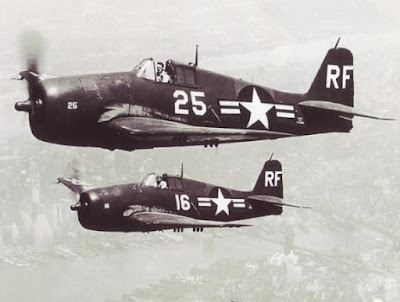The Grumman F6F Hellcat was a fighter aircraft in service with the US Navy during World War II. Being one of the fastest combat airplane in WW2, it replaced the F4F Wildcat to overcome the lethal threat posed by the Mitsubishi A6M Zero in the skies over the Pacific Ocean. With 12,275 Hellcats made between 1942 and 1945, it was one of the most massively produced aircraft in American history.
The XF6F-1 prototype flew for the first time on June 26, 1942. From its first flight, it had all the marks of a successful design. The prototype proved to be stable and easy to fly. Only some minor tail flutter was cleared up by strengthening the aft structure. After only six months of test flights, the Grumman F6F Hellcat was introduced into service in January 1943, with the first deliveries of the aircraft to the VF-9 based on USS Essex.
Although it was sturdy and heavy, the Hellcat was very fast, maneuverable, and stable as it became the outstanding dogfighter of the war in the Pacific. It was only slightly surpassed by the Vought F4U Corsair in speed. Aside from being agile, the Grumman F6F Hellcat was rugged and solidly-made. This endowed the aircraft with the capacity to sustain a lot of enemy gunfire and still be able to bring the pilot back to the carrier. The aircraft was driven by a powerful machine; a Pratt & Whitney R-2800-10W Double Wasp, 18-cylinder, radial engine, which put out 2,000 HP.
Technical Characteristics
The Grumman F6F Hellcat was a single-seat, single-engine, low-wing monoplane. Its fuselage was an all-metal construction, with frames and bulkheads being made with aluminum channels or angle sections. Longerons and stringers, made of similar materials, stretched from nose to tail, creating a grid-like pattern with the frames. The pilots was protected from enemy gunfire by a series of flat, homogeneous steel plates, which were set up from front to the rear of cockpit. The canopy was made of five pieces and it could be slid back on a track with a hand crank. Landing gear wheels folded up backwards into wing.
The Hellcat's wing center section was very stout and strong, and it held the main gear, the catapult hooks, fuselage and outer wing panels together. The aircraft foldable wing panels carried the fighter's guns and ammunition as well as the outboard flaps and ailerons. The wing panels and center wing were built in a similar way, with a slanted front spar, a rear spar extending out past the inner edge of the aileron and an aileron support spar, which was called a "rib intercostal member". Ribs extended from leading to trailing edge, while stringers ran the full span of wings.
Specifications (F6F-5 variant)
Type: single-seat, carrier-based fighter.
Length: 10.23 m (33 feet, 7 inches)
Wingspan: 13.08 m (42 feet, 10 inches)
Wing Area: 31.03 square meters (334 sq. ft.)
Height: 3.99 m (13 feet, 1 inch)
Powerplant: one 2,000-HP, Pratt & Whitney R-2800-10W radial engine
Maximum Speed: 620 km/h (380 mph)
Range: 1,675 km (1,040 miles)
Service Ceiling: 11,500 m (37.500 feet)
Armament: six 12.7mm (.50-cal.) Browning M2 machine guns set up in wings; six 127mm rockets; 907 kg of bombs.
Below, two F6Fs flying over New York City. The photo was taken after the war in the Pacific.
The prototype XF6F-2 in 1942.
Below, two F6F-5P reconnaissance aircraft in August 1945.
A Grumman F6F-3 variant in flight in June 1943.
The Hellcats in action in the Pacific in 1944 (video)







